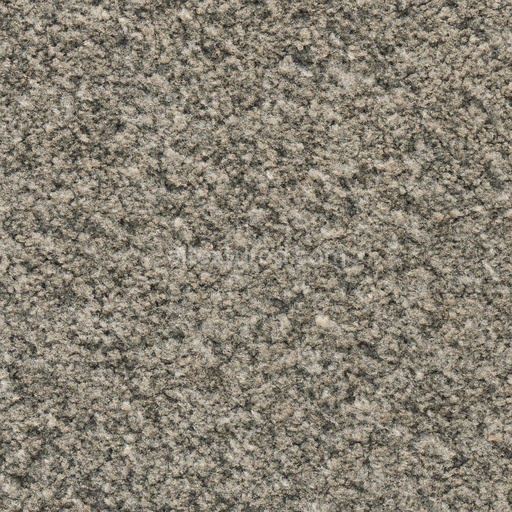This Rough Granite Texture Seamless high resolution up to 8ktexture captures the intricate natural composition of granite, a durable igneous stone primarily composed of quartz, feldspar, and mica minerals. The texture reflects the coarse-grained crystalline structure and subtle mineral variations typical of granite, including grain orientation and small interstitial pores resulting from its slow cooling process. The surface finish is authentically rough and unpolished, showcasing natural weathering and micro-erosion patterns that enhance realism. Coloration arises from the complex blend of mineral pigments—soft grays, muted whites, and occasional flecks of pink or black—mirroring the oxide layers and mineral impurities found in natural stone. This seamless rough granite texture excels in conveying the tactile, rugged feel of stone through its balanced, organic details.
Technically, the texture is optimized for physically based rendering (PBR) workflows, with high resolution up to 8k ensuring crisp detail even on large UV islands without loss of clarity or cohesion. The BaseColor/Albedo channel accurately displays the nuanced granite hues and subtle tonal shifts, while the Normal map emphasizes the coarse grain and micro-relief of the stone surface. The Roughness channel controls the diffuse, matte finish typical of rough granite, avoiding unwanted glossiness and maintaining a natural stone appearance. Metallic values are minimal, consistent with non-metallic stone materials, and Ambient Occlusion enhances shadowing within crevices and grain boundaries. Height/Displacement maps provide depth for parallax effects or tessellation, allowing realistic surface bumpiness in real-time scenes or cinematic renders. This tileable rough granite texture seamless high resolution up to 8ktexture is fully compatible and ready to use with Blender, Unity, and Unreal Engine, integrating effortlessly into modern 3D pipelines with minimal setup.
Ideal for a variety of applications—from architectural visualization and level dressing to material studies and cinematic environments—this texture brings a high-quality, natural stone aesthetic to your projects. To optimize appearance in your scene, consider adjusting the roughness intensity to match your lighting conditions, ensuring the granite’s tactile feel remains grounded and believable. Additionally, fine-tuning UV scale can help emphasize or soften the grain structure based on your design needs. Whether used for real-time rendering or offline production, this rough granite texture seamless high resolution up to 8ktexture offers a versatile and realistic solution for stone surfaces in 3D workflows.
This AI-generated seamless rough granite texture offers a seamless high resolution up to 8k, providing detailed stone textures with realistic PBR appearance and a 3D preview to evaluate its material composition accurately.
How to Use These Seamless PBR Textures in Blender
This guide shows how to connect a full PBR texture set to Principled BSDF in Blender (Cycles or Eevee). Works with any of our seamless textures free download, including PBR PNG materials for Blender / Unreal / Unity.
What’s inside the download
*_albedo.png — Base Color (sRGB)*_normal.png — Normal map (Non-Color)*_roughness.png — Roughness (Non-Color)*_metallic.png — Metallic (Non-Color)*_ao.png — Ambient Occlusion (Non-Color)*_height.png — Height / Displacement (Non-Color)*_ORM.png — Packed map (R=AO, G=Roughness, B=Metallic, Non-Color)

Quick start (Node Wrangler, 30 seconds)
- Enable the addon: Edit → Preferences → Add-ons → Node Wrangler.
- Create a material and select the Principled BSDF node.
- Press Ctrl + Shift + T and select the maps
albedo, normal, roughness, metallic (skip height and ORM for now) → Open.
The addon wires Base Color, Normal (with a Normal Map node), Roughness, and Metallic automatically.
- Add AO and Height using the “Manual wiring” steps below (5 and 6).
Manual wiring (full control)
- Create a material (Material Properties → New) and open the Shader Editor.
- Add an Image Texture node for each map. Set Color Space:
- Albedo → sRGB
- AO, Roughness, Metallic, Normal, Height, ORM → Non-Color
- Connect to Principled BSDF:
albedo → Base Colorroughness → Roughnessmetallic → Metallic (for wood this often stays near 0)normal → Normal Map node (Type: Tangent Space) → Normal of Principled.
If details look “inverted”, enable Invert Y on the Normal Map node.
- Ambient Occlusion (AO):
- Add a MixRGB (or Mix Color) node in mode Multiply.
- Input A =
albedo, Input B = ao, Factor = 1.0.
- Output of Mix → Base Color of Principled (replaces the direct albedo connection).
- Height / Displacement:
Cycles — true displacement
- Material Properties → Settings → Displacement: Displacement and Bump.
- Add a Displacement node: connect
height → Height, set Midlevel = 0.5, Scale = 0.02–0.08 (tune to taste).
- Output of Displacement → Material Output → Displacement.
- Add geometry density (e.g., Subdivision Surface) so displacement has polygons to work with.
Eevee (or lightweight Cycles) — bump only
- Add a Bump node:
height → Height.
- Set Strength = 0.2–0.5, Distance = 0.05–0.1, and connect Normal output to Principled’s Normal.
Using the packed ORM texture (optional)
Instead of separate AO/Roughness/Metallic maps you can use the single *_ORM.png:
- Add one Image Texture (Non-Color) → Separate RGB (or Separate Color).
- R (red) → AO (use it in the Multiply node with albedo as above).
- G (green) → Roughness of Principled.
- B (blue) → Metallic of Principled.
UVs & seamless tiling
- These textures are seamless. If your mesh has no UVs, go to UV Editing → Smart UV Project.
- For scale/repeat, add Texture Coordinate (UV) → Mapping and plug it into all texture nodes.
Increase Mapping → Scale (e.g., 2/2/2) to tile more densely.
Recommended starter values
- Normal Map Strength: 0.5–1.0
- Bump Strength: ~0.3
- Displacement Scale (Cycles): ~0.03
Common pitfalls
- Wrong Color Space (normals/roughness/etc. must be Non-Color).
- “Inverted” details → enable Invert Y on the Normal Map node.
- Over-strong relief → lower Displacement Scale or Bump Strength.
Example: Download Wood Textures and instantly apply parquet or rustic planks inside Blender for architectural visualization.
To add the downloaded texture, go to Add — Texture — Image Texture.

Add a node and click the Open button.

Select the required texture on your hard drive and connect Color to Base Color.


